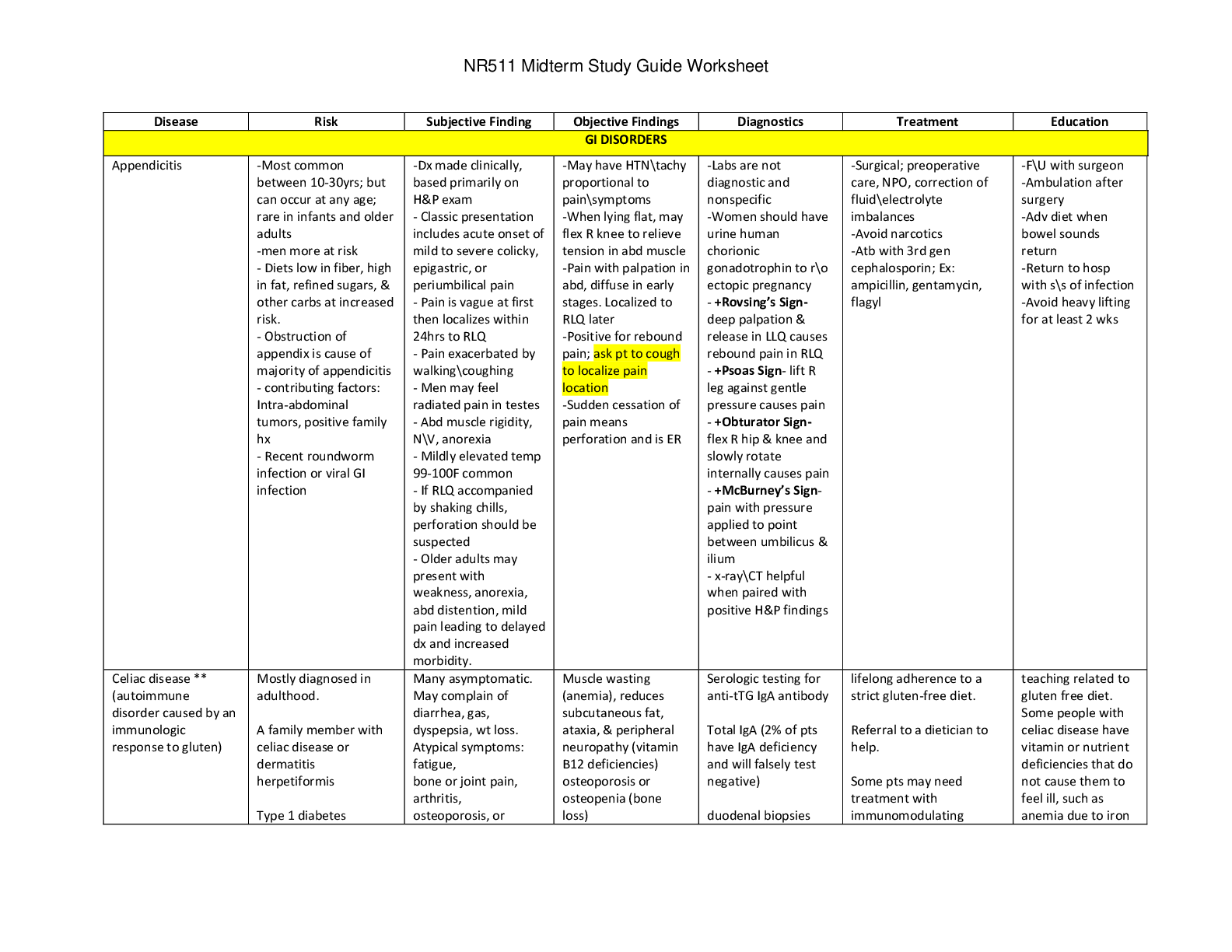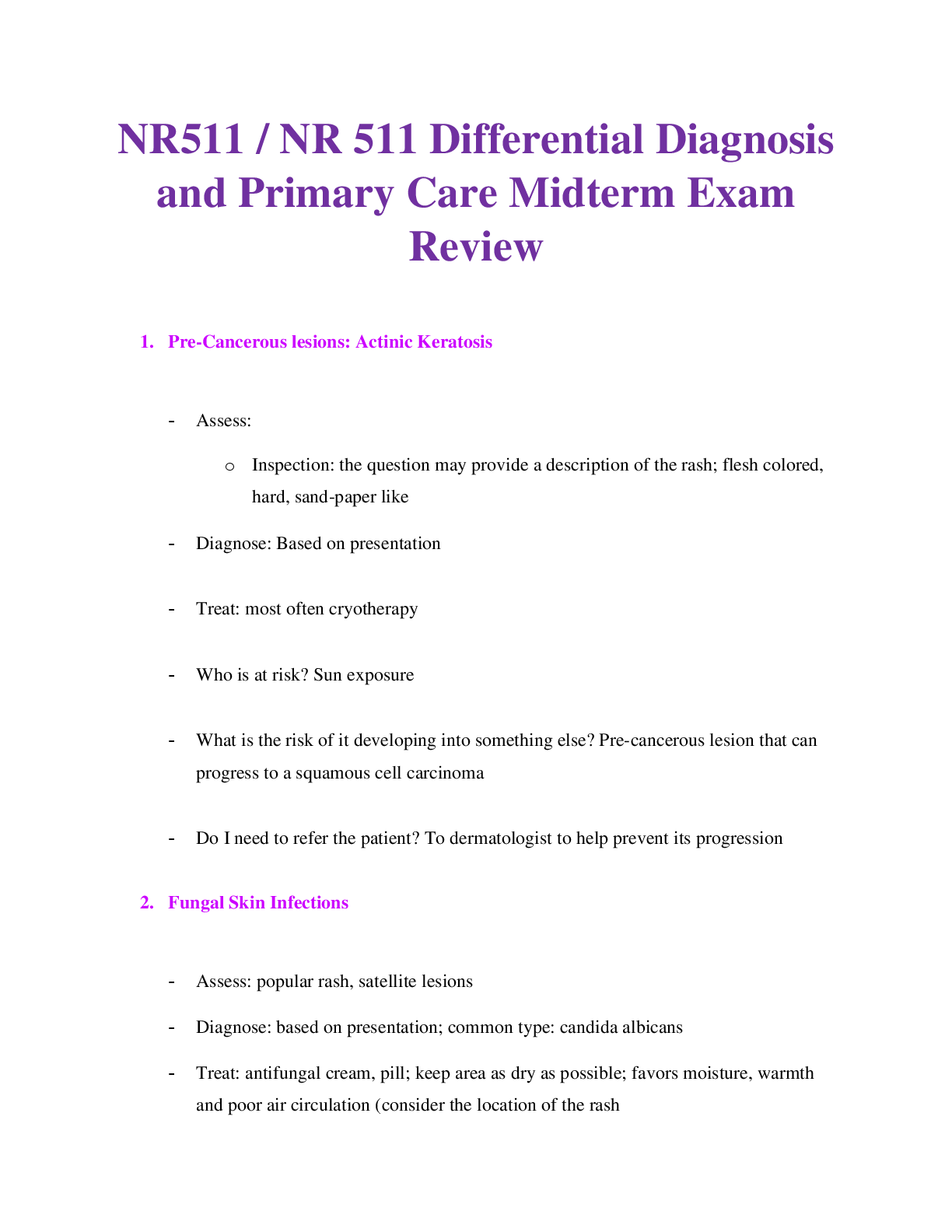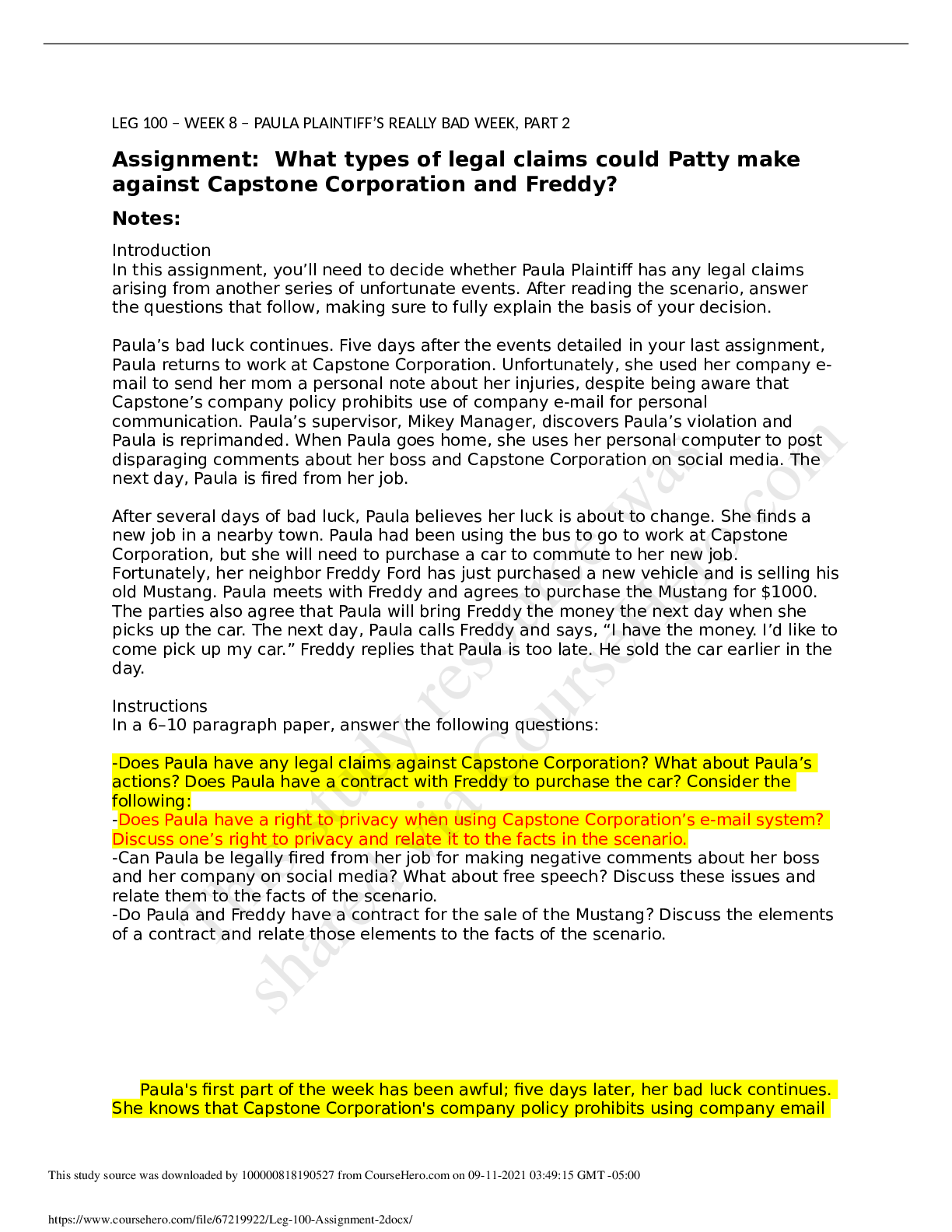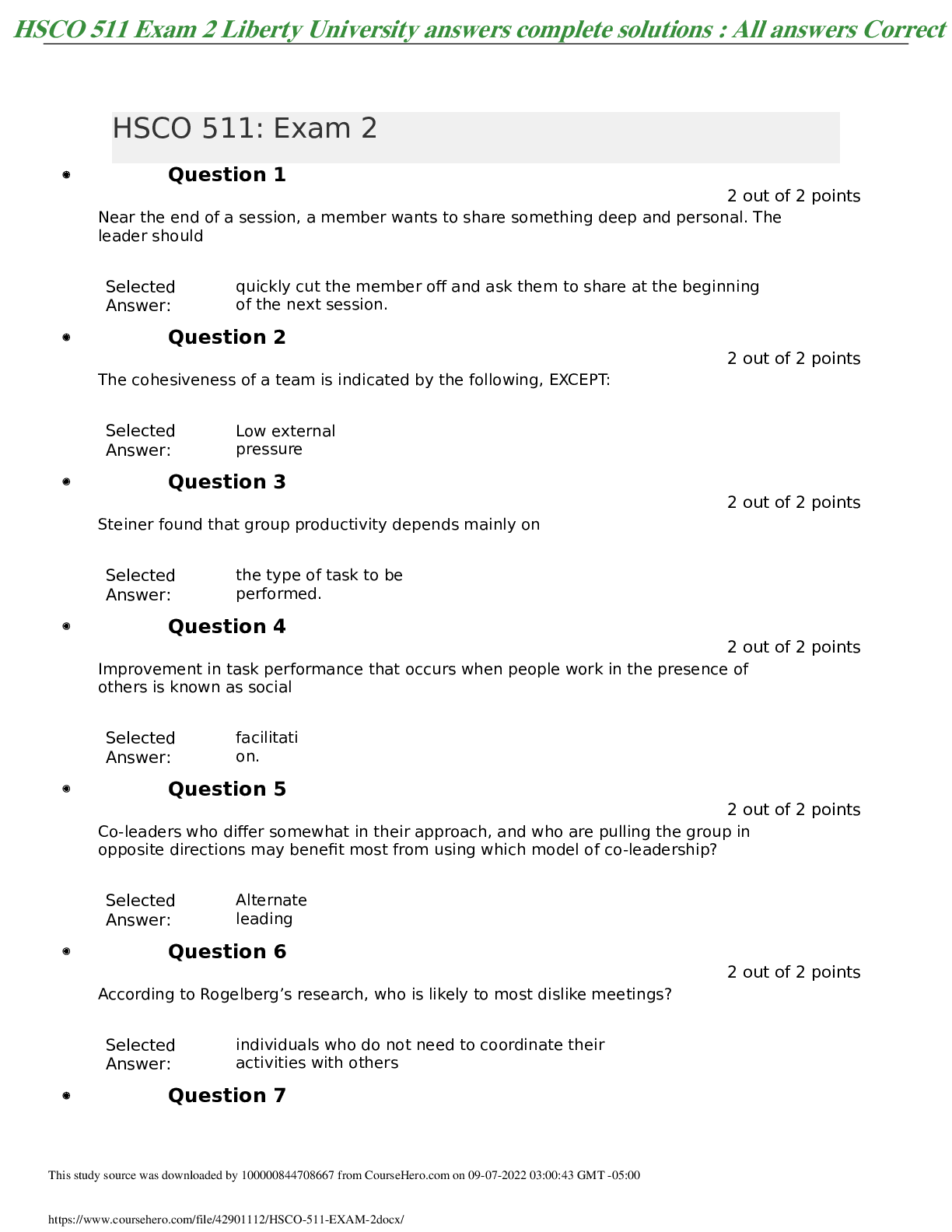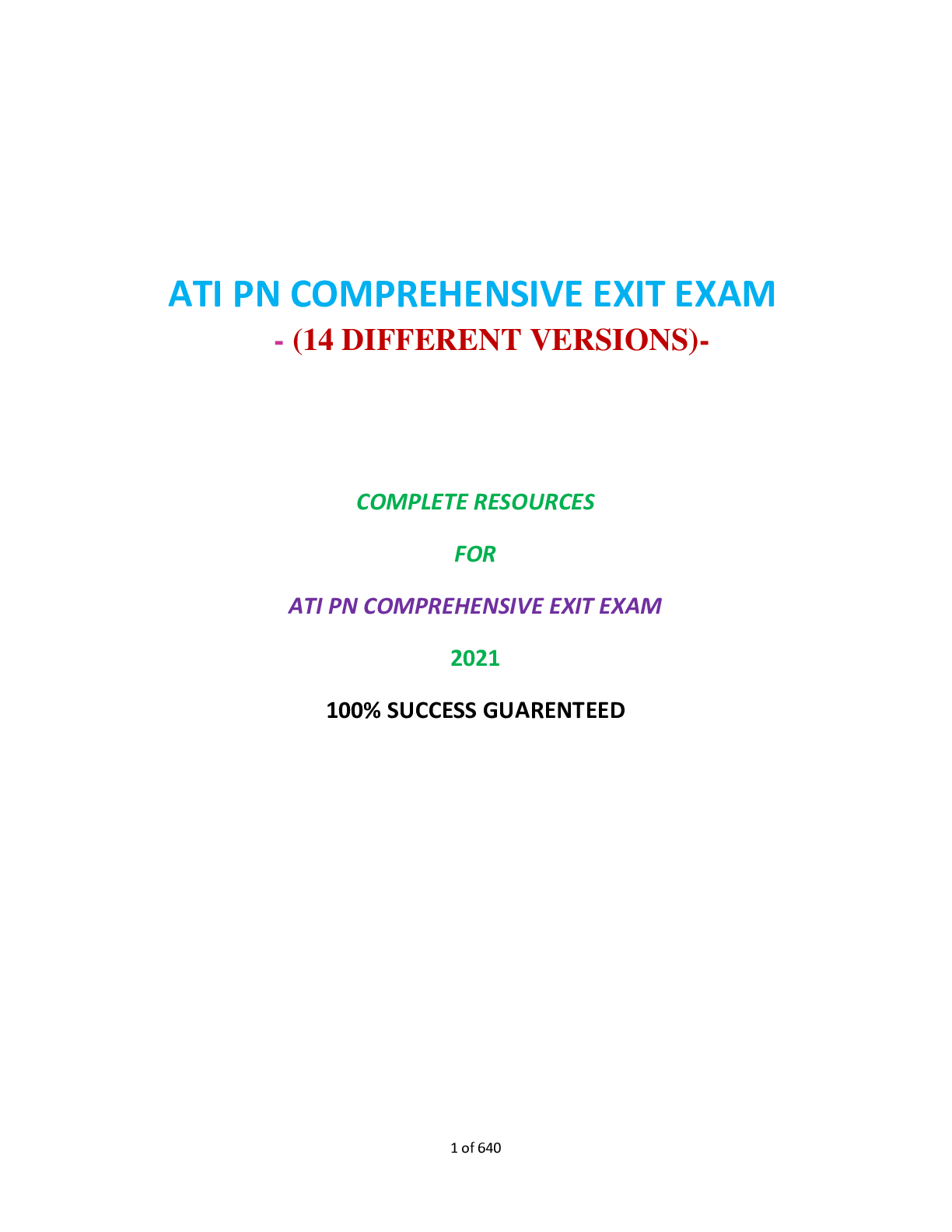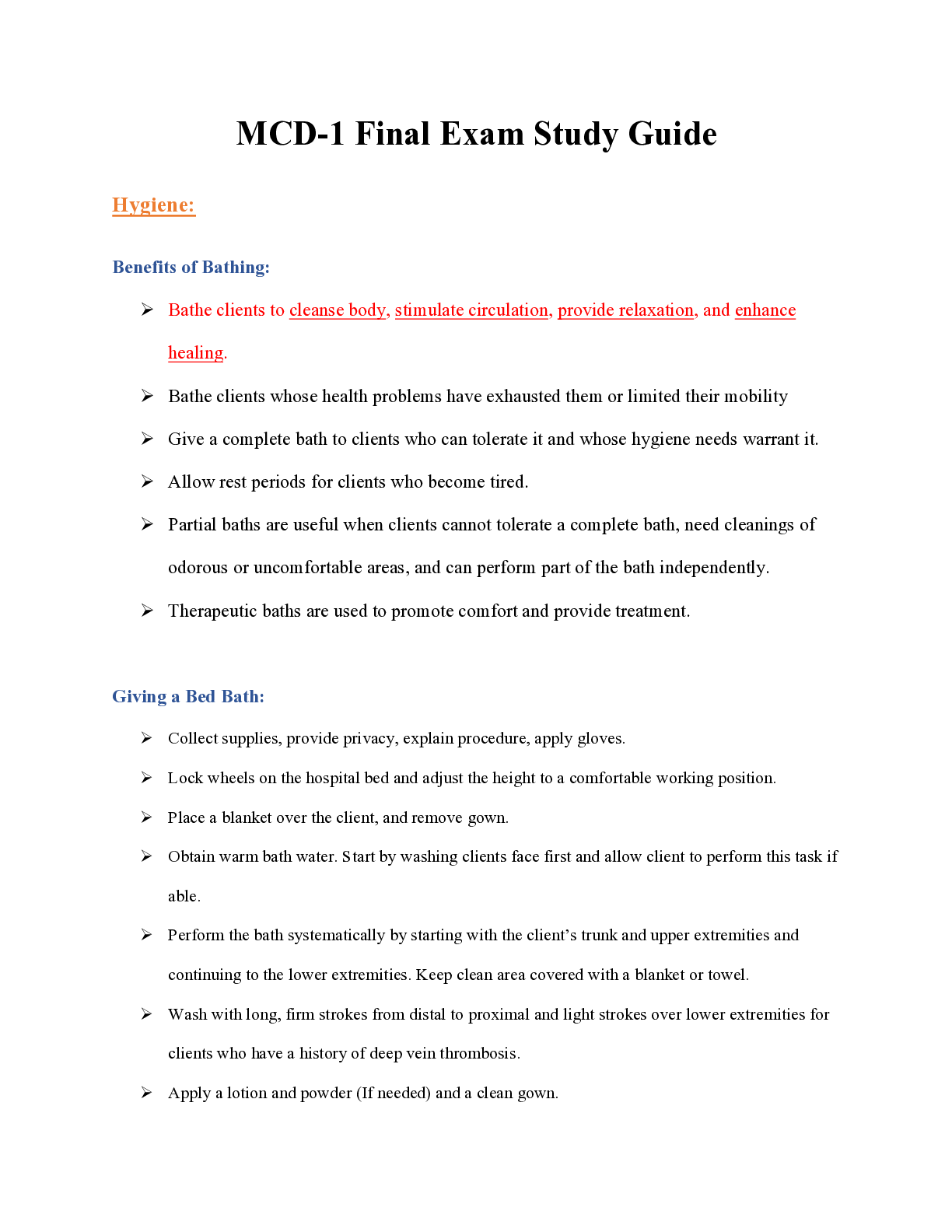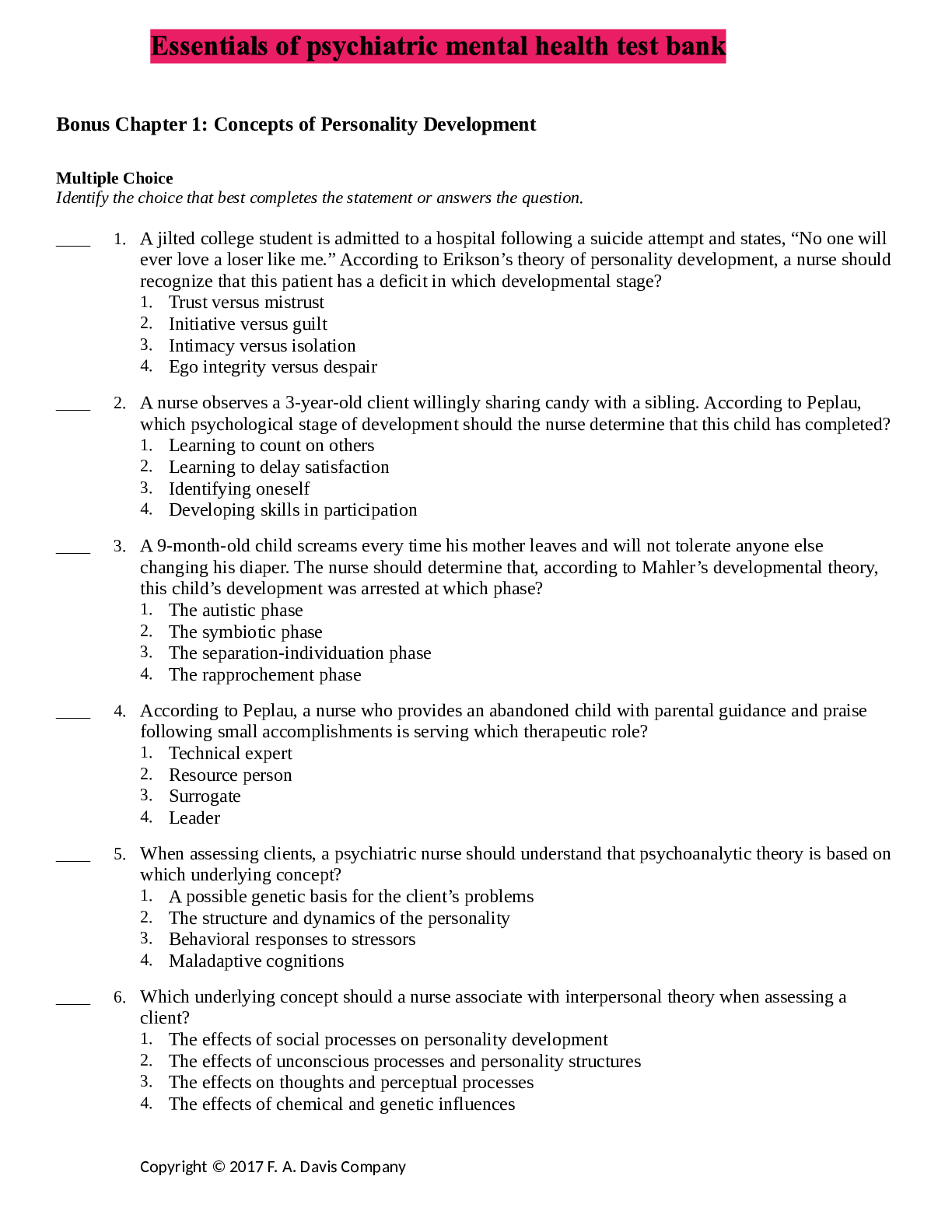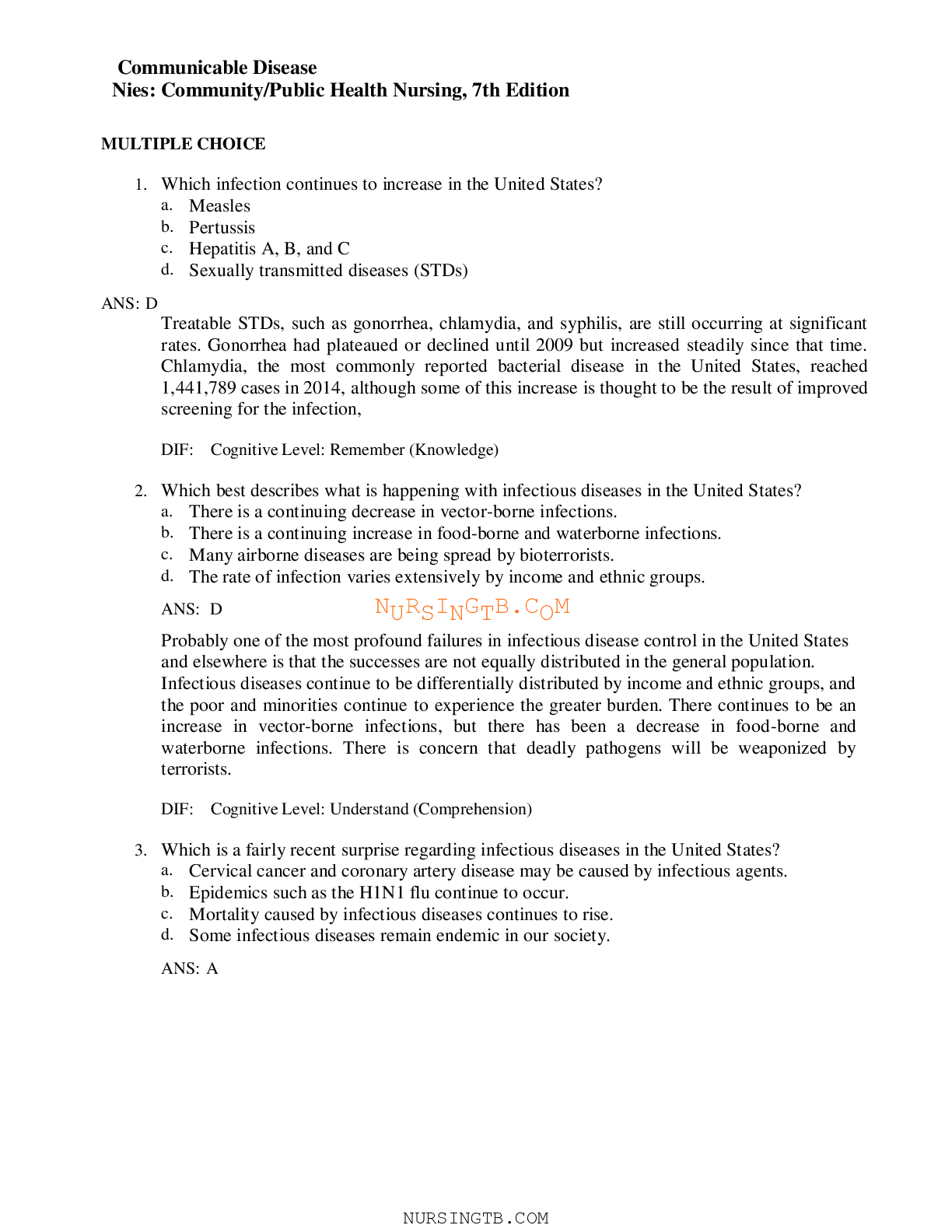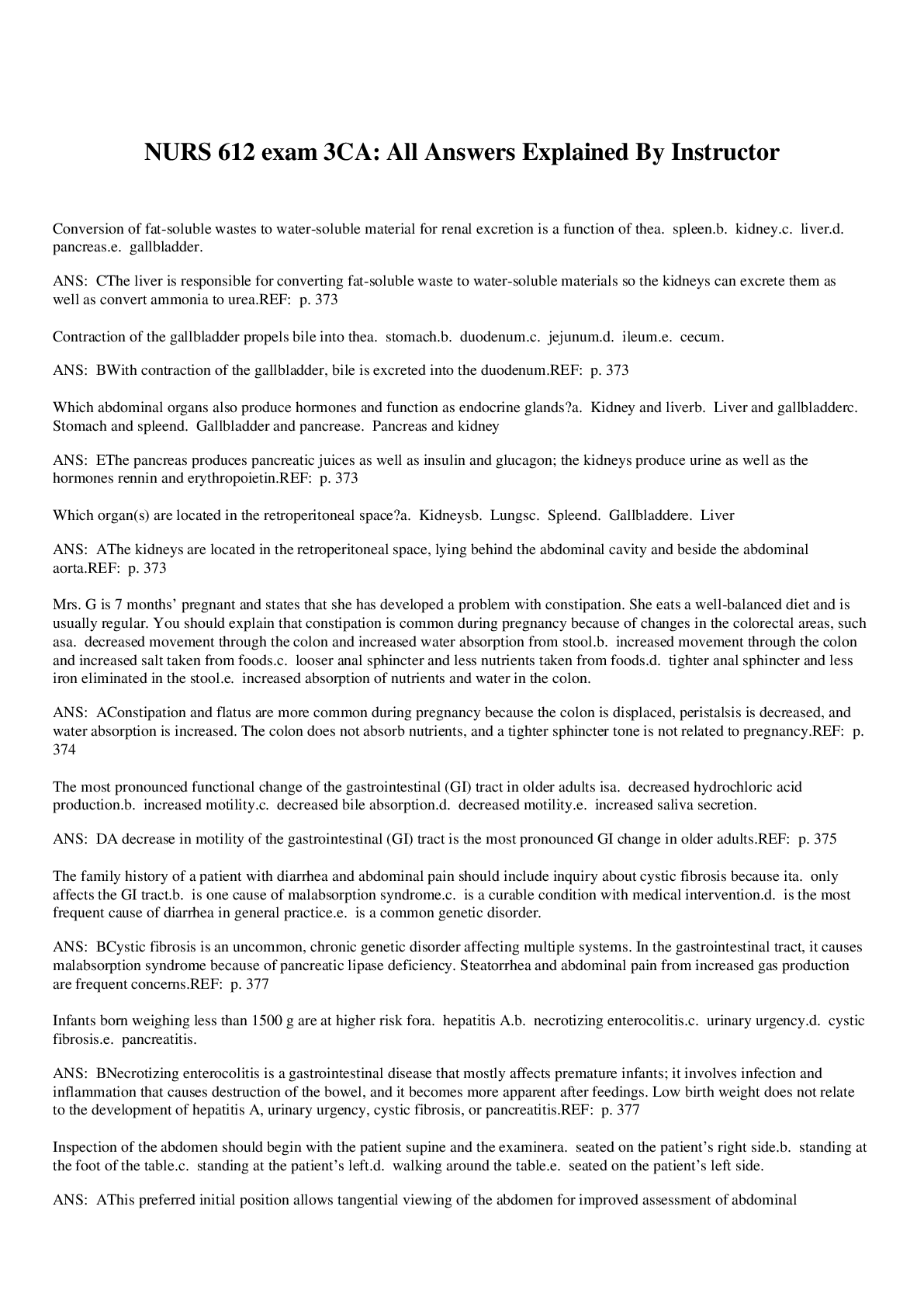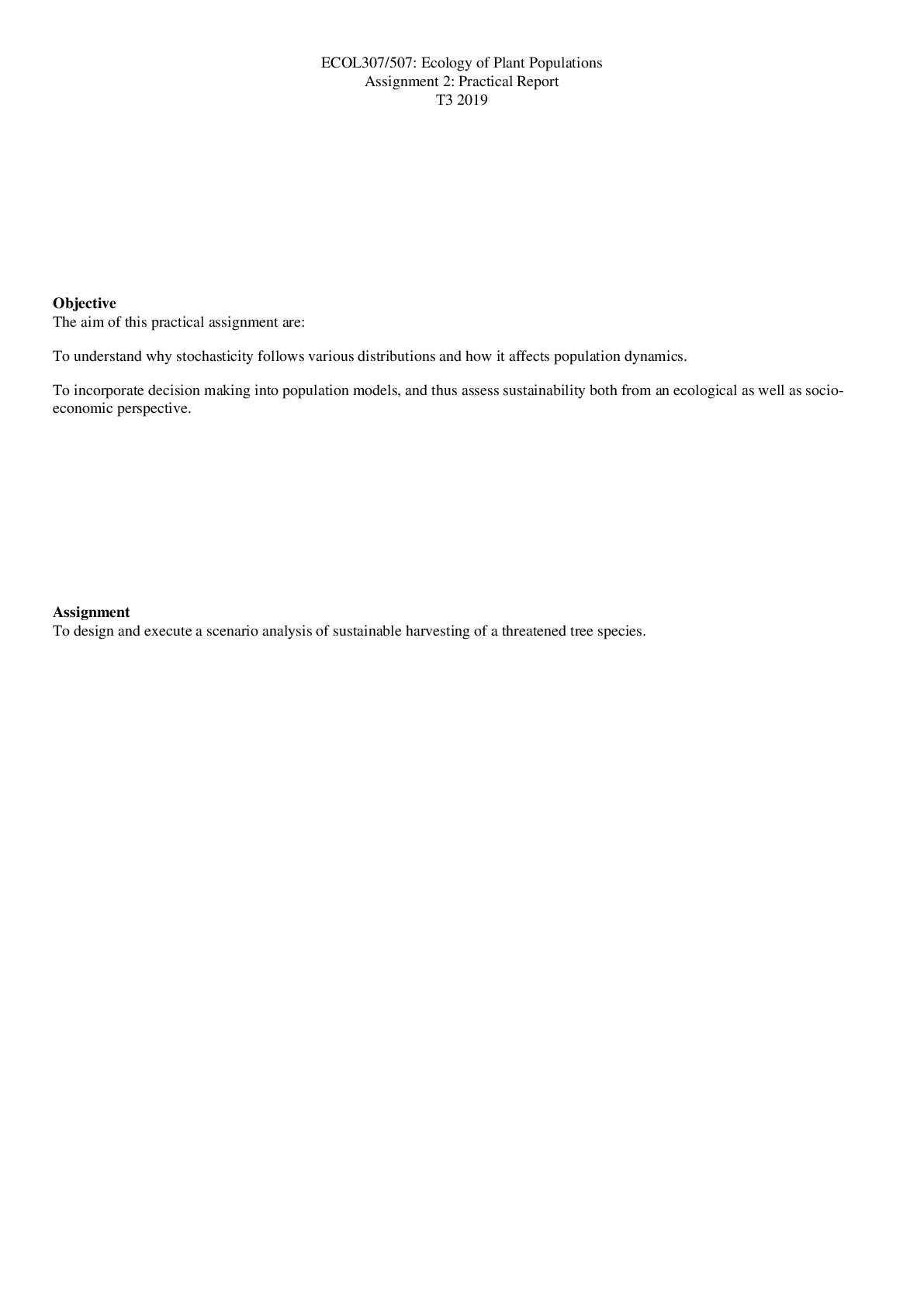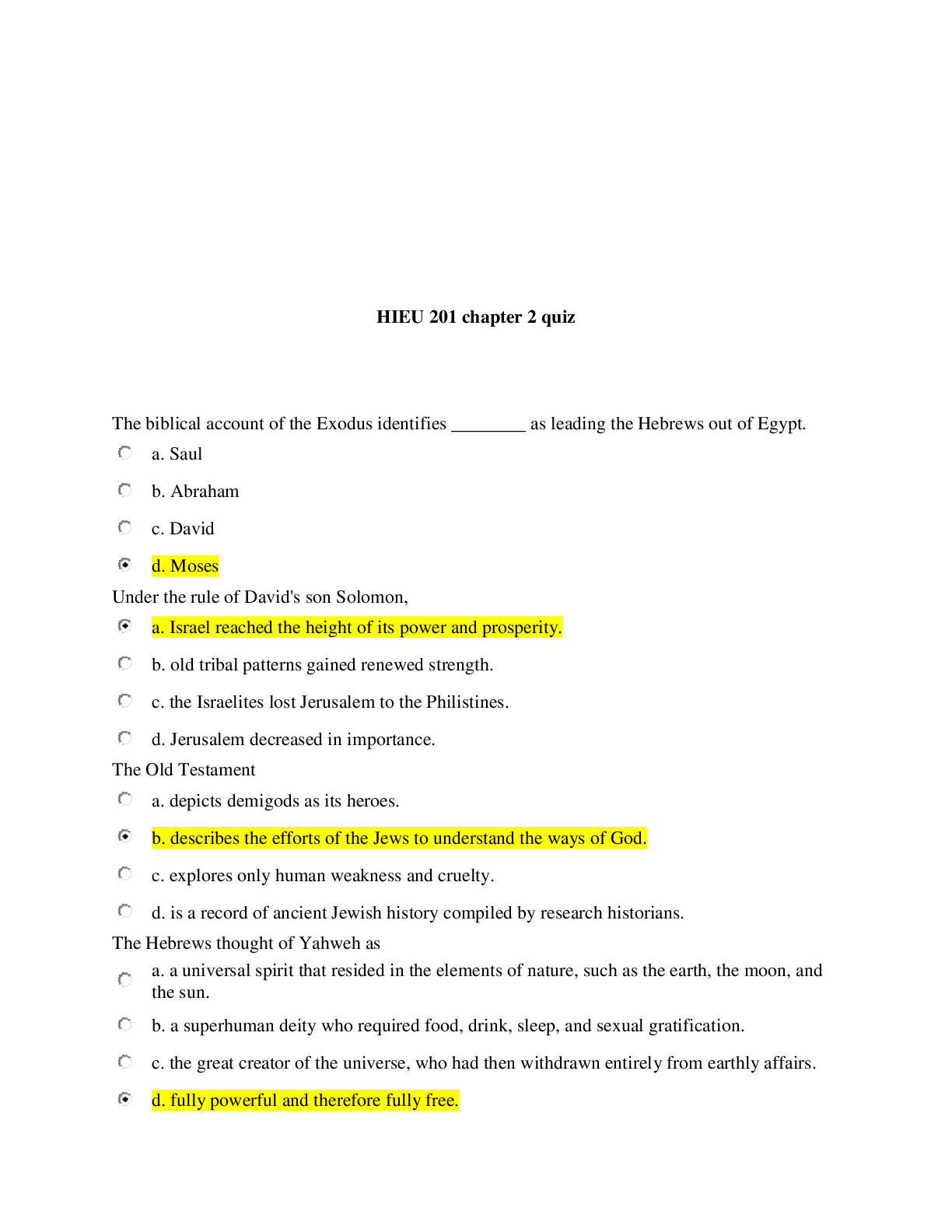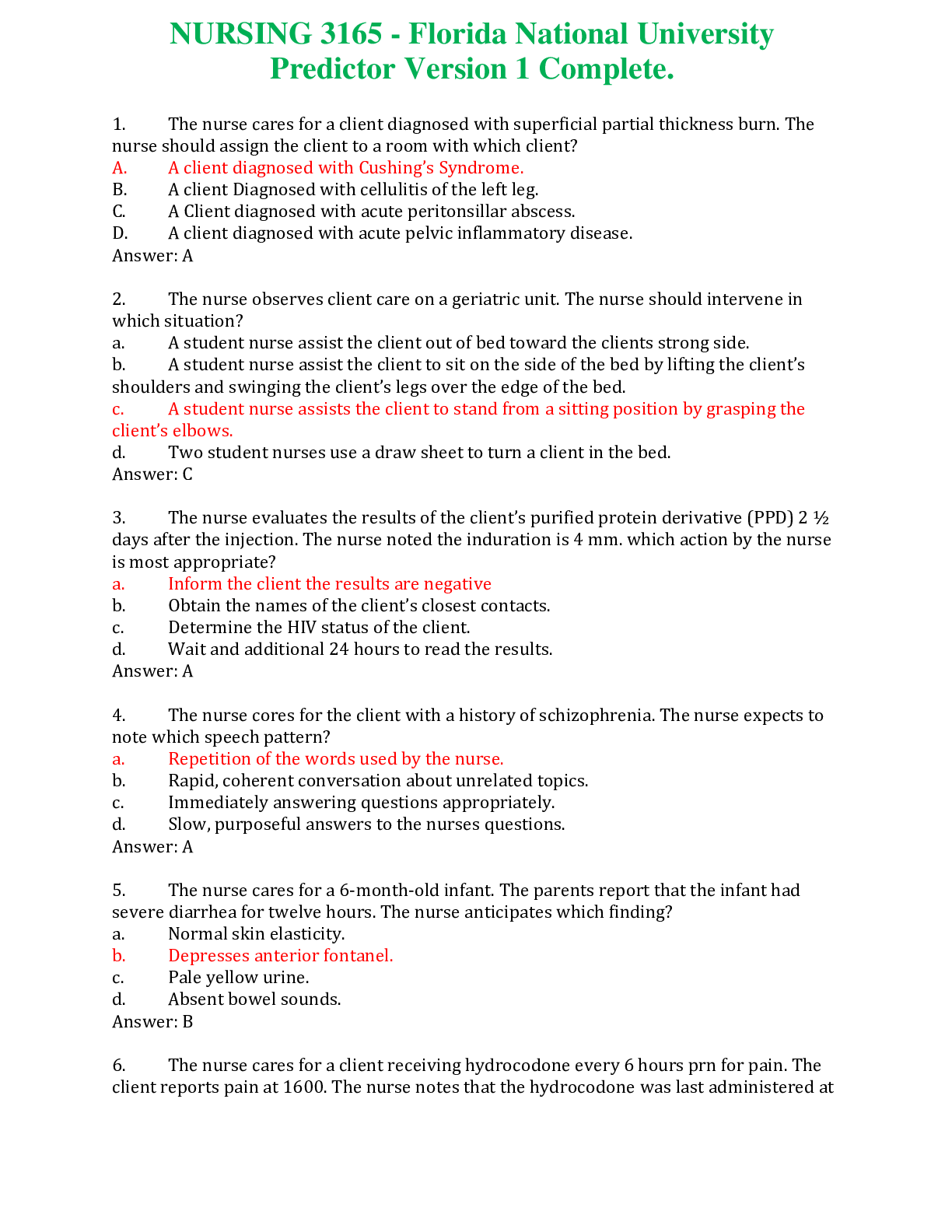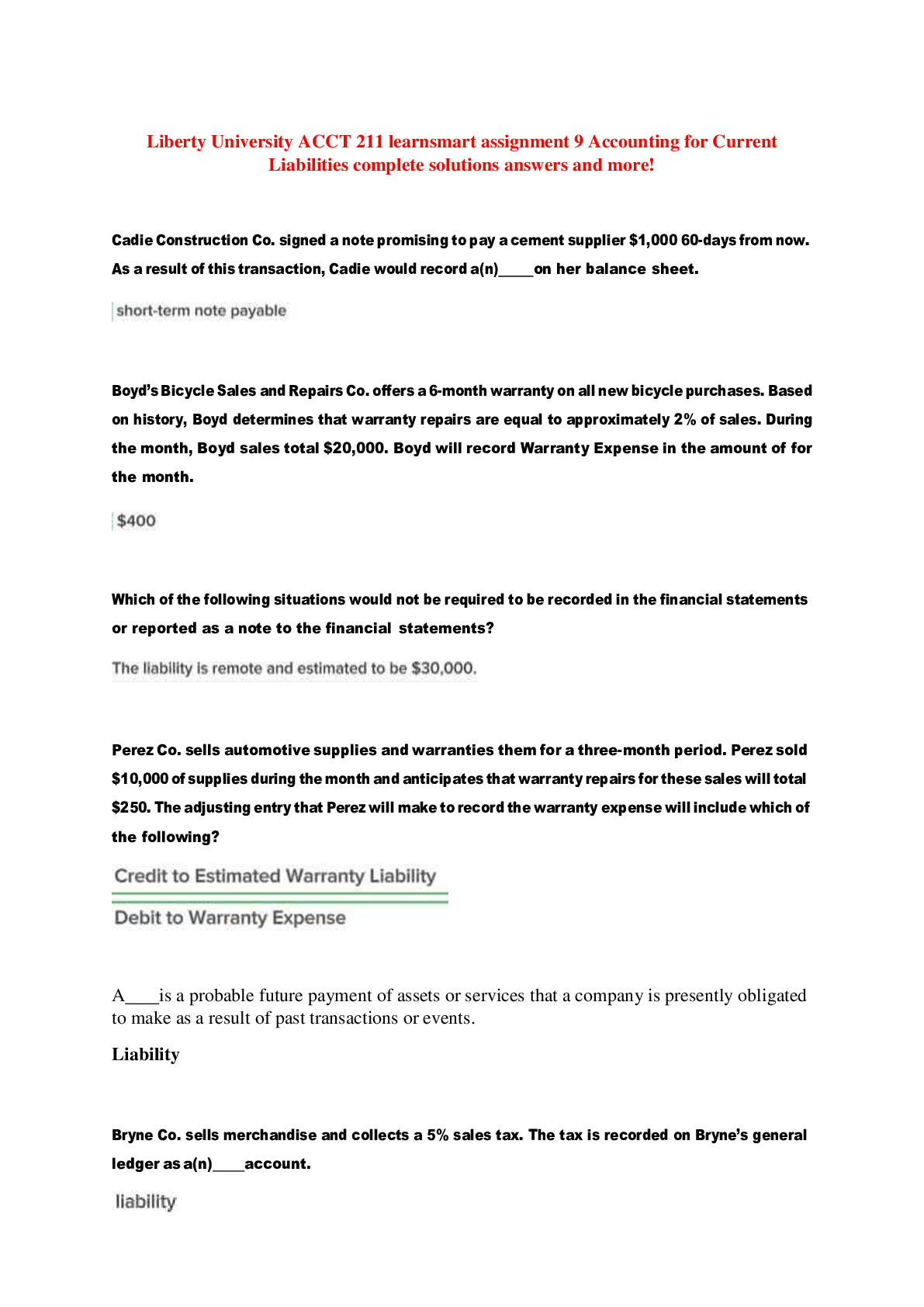*NURSING > QUESTIONS & ANSWERS > NR 222 Final Exam (All)
NR 222 Final Exam
Document Content and Description Below
NR 222 Final Exam / Chamberlain NR222 Final Exam NOTE: Remember NR 222 requires you to attend the lecture, read the assigned readings, and practice NCLEX style questions to be successful on our e... xams. The intent of this study tool is to outline the major content that will be covered on the exam. Additional content may be included on the exam. Define the following terms: Nursing Process: The Standards of Practice describe a competent level of nursing care. The levels of care are demonstrated by a critical thinking model known as the nursing process: assessment, diagnosis, outcomes identification and planning, implementation, and evaluation (ANA, 2010b). The nursing process is the foundation of clinical decision making and includes all significant actions taken by nurses in providing care to patients Assessment Diagnosis Planning Implementation E valuation Teaching & Education: Teach information that the patients and families need to make informed decisions. Determine what patients need to know. Identify risks and patients willingness and ability to learn. Teaching: imparting knowledge through series of directed activities Learning: purposeful acquisition of knowledge, attitudes, behaviors and skills HP 20/20 Concepts: Overarching Goals: 1. High-quality longevity free of preventable disease 2. Health equity amongst/ across all groups 3. Create social/ physical environments that promote good health for all. 4. Promotion of healthy behaviors, development, and quality across all life stages Different concepts of Health Promotion: Definition: Health promotion includes activities such as routine exercise and good nutrition that help patients maintain or enhance their present levels of health. 3 areas of focus: 1. individual characteristics and experiences 2. behavior-specific knowledge and effect 3. behavior outcomes, commitment to change a behavior Therapeutic Communication It is a face to face process of interacting that focuses on advancing the physical and emotional well being of the patient. Nurses use to provide support and information to the patients (Facilitates positive change and growth). Empathy, clarifying, focusing, paraphrasing, summarizing, self-disclosure, sharing, hope, humor, feelings, using touch, using silence and providing information. Ethical Principles in nursing 1. Autonomy (Autonomy, self-determination, informed consent, confidentiality, HIPPA) 2. Non-Maleficence (Do no harm) 3. Beneficence (Do good) 4. Veracity (devotion to truth) 5. Justice (Fairness) Lifespan/Theorists 1. Erikson’s Theory of Psychosocial Development: “tasks to be mastered” 2. Piaget’s stages of cognitive development: “thinking” 3. Kohlberg’s theory of moral development: “right vs. wrong” Health literacy/Equity Health Literacy Definition: Health literacy is the ability to obtain, process, and understand health information needed to make informed health decisions. health literacy has direct effects on health outcomes, linking poor health outcomes to limited health literacy. More specifically, lower health literacy has been associated with a higher risk of mortality. Health Equity Definition: Health equity. Equity is the absence of avoidable, unfair, or remediable differences among groups of people, whether those groups are defined socially, economically, demographically or geographically or by other means of stratification (WHO). Health Education: Levels of Prevention: Definitions: 1. Primary: is true prevention; it precedes disease 2. secondary: focuses on the individuals who are experiencing health problems or illnesses and who are at risk for developing complications or worsening conditions. 3. tertiary: occurs when a defect or disability is permanent and irreversible; it involves minimizing the effects of the illness or disability. Holistic Care/Chamberlain care Self, Peer, clients CAM (Complementary Alternative Medication) Complementary therapies are therapies used in addition to or together with conventional treatment recommended by a person's health care provider. Alternative therapies sometimes include the same interventions as complementary therapies, but they become the primary treatment Answer the following questions: 1. What are the many roles that nurses play in healthcare? Ex. Case manager, Advocate Autonomy, caregiver, advocate, educator, communicator, manager, Advance practice nurse (APRN), Clinical Nurse Specialist (CNS), Nurse Practioner (NP), Certified Nurse-Midwife CNM), Certified Registered Nurse Anesthetist (CRNA), Nurse Educator, nursing administrator, nurse researcher. 2. What are the twelve topics within Healthy People 20/20? What is the focus of each lead health indicator? Has there been progress towards each initiative? Which areas have worsened? (Slide 58-62) 1. Access to Health Services: medical insurance, Primary Care Providers 2. Clinical Preventive Services: Vaccines, Screenings (HPB, MMR/Polio/TDap, Colorectal Screening 3. Environmental Quality: Air quality index, secondhand smoke *MOST IMPROVED 4. Injury and Violence: Fatal injuries, homicides 5. Maternal, Infant and Child Health: All infant deaths and preterm births 6. Mental Health: suicide and adolescent depression *LEAST QUALITY IMPROVEMENT 7. Nutrition, Physical Activity and Obesity: physical activity, obesity in adults and children 8. Oral Health: persons attending dentist/year * LEAST QUALITY IMPROVED 9. Reproductive Health: females receiving reproductive services, serostatus in HIV persons 10. Social Determinants: high school graduation rates 11. Substance Abuse: adolescents using alcohol, adults binge drinking 12. Tobacco: Adult current smokers, adolescent past 30-day smokers 3. What is the nurse’s role in health promotion? How do we use our knowledge to help our patients/communities? 1. primary prevention through education and teaching 2. health promotion model slide 55 3. professionals involved in health promotion are responsible for foreseeing predictable adverse events 4. suggest behaviors related to families developmental stage 4. How does a nurse go about providing health restoration? • Restoration of health: Patients recovering from and adapting to changes resulting from illness or injury often seek information about their conditions. The family often is a vital part of a patient’s return to health. Family caregivers usually require as much education as the patient, including information on how to perform skills within the home. 5. How do we incorporate holistic health care into a patient’s care plan? (Slide 5 & 6) Mind, body & spirit is Holistic nursing that advances health and well being through caring/healing relationships. -make sure to not just treat the symptoms at hand but everything as a whole. 6. Name the different CAM methods discussed in the lecture and in your readings. Complementary and alternative medicine (CAM) as “an array of health care approaches with a history of use or origins outside of mainstream medicine.” Complementary therapies are therapies used in addition to or together with conventional treatment recommended by a person's health care provider. As the name implies, complementary therapies complement conventional treatments. Complementary therapies also include relaxation; exercise; massage; reflexology; prayer; biofeedback; hypnotherapy; creative therapies, including art, music, or dance therapy; meditation; chiropractic therapy; and herbs/supplements, guided imagery, therapeutic touch 7. What are the different components of SBAR and how do nurses use the tool to communicate? Use when communicating and sharing information. Situation- brief, clear and succinct overview of pertinent info. Background- briefly state the history Assessment- summarize the facts and give your best assessment Recommendation- what actions are you asking for? What do you want to happen next 8. What are some stress management techniques? And which stressors are considered modifiable? (SLIDE 10) Self awareness, relaxation, expression writing, healthy diet, physical activity, sleep hygiene, cognitive-behavioral restructuring, affirmations, social support, assertive communication, empathy, engaging in healthy pleasures, spiritual ptactices, clarifying values and beliefs, realistic goals, humor and effective coping. Situational Factors-Arise from job changes, illness, caregiver stress Maturational Factors-Vary with life stages Sociocultural Factors-Environmental, social, and cultural stressors perceived by children, adolescents and adults. 9. What are the components of the nursing process and how does the nurse use them to promote health? Assessment Diagnosis Planning Implementation Evaluation 10. Name the three levels of prevention? Definitions: 4. Primary: is true prevention; it precedes disease 5. secondary: focuses on the individuals who are experiencing health problems or illnesses and who are at risk for developing complications or worsening conditions. 6. tertiary: occurs when a defect or disability is permanent and irreversible; it involves minimizing the effects of the illness or disability. 11. List and describe the ANA Code of Ethics discussed in the lecture and in your ANA Code of Ethics book? Box 1-3 ANA Standards of Professional Performance 1. Ethics: The registered nurse practices ethically. 2. Education: The registered nurse attains knowledge and competency that reflects current nursing practice. 3. Evidence-Based Practice and Research: The registered nurse integrates evidence and research findings into practice. 4. Quality of Practice: The registered nurse contributes to quality nursing practice. 5. Communication: The registered nurse communicates effectively in all areas of practice. 6. Leadership: The registered nurse demonstrates leadership in the professional practice setting and the profession. 7. Collaboration: The registered nurse collaborates with health care consumers, families, and others in the conduct of nursing practice. 8. Professional Practice Evaluation: The registered nurse evaluates her or his own nursing practice in relation to professional practice standards and guidelines, relevant statutes, rules, and regulations. 9. Resources: The registered nurse uses appropriate resources to plan and provide nursing services that are safe, effective, and financially responsible. 10. Environmental Health: The registered nurse practices in an environmentally safe and healthy manner. 12. What is culturally congruent care? The goal of transcultural nursing is to provide culturally congruent care or care that fits a person's life patterns, values, and system of meaning. Patterns and meaning are generated by people themselves rather than from predetermined criteria. 13. Name and describe the three teaching domains. Cognitive (Understanding) Affective (Attitude/feelings) Psychomotor (Motor Skills) 14. Describe each part of the SBAR Situation- brief, clear and succinct overview of pertinent info. Background- briefly state the history Assessment- summarize the facts and give your best assessment Recommendation- what actions are you asking for? What do you want to happen next [Show More]
Last updated: 1 year ago
Preview 1 out of 15 pages
Instant download

Buy this document to get the full access instantly
Instant Download Access after purchase
Add to cartInstant download
Reviews( 0 )
Document information
Connected school, study & course
About the document
Uploaded On
Aug 24, 2021
Number of pages
15
Written in
Additional information
This document has been written for:
Uploaded
Aug 24, 2021
Downloads
0
Views
56

